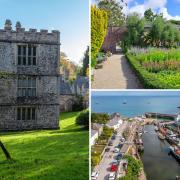The new president of the Country Land and Business Association, Henry Robinson, shares some of his thoughts for the future
I am lucky enough to live and work in a very beautiful part of the world – and that is something that is never lost on me - but it also gives rise to the question about how we strike the balance in the use of the land and, indeed, what the proper use of land is.
The South West is the most important livestock producing area in the country, it is also the most popular tourist destination in the UK, it has two national Parks and more designated areas – places like Areas of Outstanding Natural Beauty - than anywhere else in Britain.
At the core of all those points is the land. Our stunning landscapes, our tranquil environment, picturesque villages and our built and natural heritage - all shaped and cultured by man and now, managed by us.
This landscape, this environment, is one of the key reasons some 20 million visitors a year come to our region and, in doing so, add some £4 billion to the total income from tourism.
As president of the CLA, this question of balance in land use is going to be with me for the whole of my two-year-term of office. With a burgeoning world population, food production is, of course, going to remain of paramount importance – we are going to need an awful lot of food to feed seven billion people over the next 40 years - but there are other, often critical, demands being made upon us as landowners such as energy production, water, housing, biodiversity, recreation, peace and tranquillity – it’s a long list and at every twist and turn there are costs.
Whether it’s managing the patchwork quilt of the Cornish countryside, the wild country of Exmoor and Dartmoor, the Dorset Heath, the Wiltshire Downs or the rolling beauty of the Cotswolds, all of it has a cost associated with it. For the majority of people that management regime is just something that happens, almost by magic. For those of us involved in the management of the land we know the expectation placed upon us – but we also know the costs involved.
We have to set this against the background of farm incomes – good environmental management needs profitable farming - you can’t afford to be green unless you’re in the black. Without the Single Farm Payment, total income from farming would have been negative in nine out of the last 13 years. In simple terms, many of our small South West farms, particularly in our upland areas, would not survive without that support – and if they fail, so does the environmental management they provide.
Many do not like the concept of subsidy, but no other industry has the same level of public expectation laid across its shoulders – and almost every other country in the world, including New Zealand, subsidies its farmers, whether that’s through fuel costs or export subsidies or direct support.
That is why it is so important for me that we ensure this next round of reform to the Common Agricultural Policy results in a simple and workable system, one that will continue to pick up the bills for the environmental benefits farming provides when the market fails to do so. We have to help the politicians and the civil servants arrive at a system that will deliver on all its expectations but, at the same time, we know there is no more money left - within this country or Europe – to pick up any extra costs so we have to make sure that what we have works as effectively and as efficiently as it possibly can.
We need to understand that if the public expectation is for us to plant crops for song birds or for pollinators that there is a natural and annual cost associated with that and we simply have to get clever about the way in which we meet those costs.
Within our region there are conflicts about using land for such things as energy crops and housing – but we have always used land for a whole variety of different purposes. Two hundred years ago, 30 per cent of our farmed land was used to grow hay and barley to fuel our horses that were our transport system and hauled our machinery around – now we are looking at biofuels, biomass and wind farms.
At the same time, we are clearly going to need more houses. The debates on Exmoor and Dartmoor pit second home owners against the indigenous population – but it is no good having just homes, the people in those homes need jobs and services to support them. The previous government thought the solution was to concentrate everything on large-scale urban development where all the infrastructure and service provision is so much cheaper – but that, of course, is to deny the rurality of our region and all that it adds to our cultural diversity.
The problem is that nobody wants to put houses where houses have not been before – but I think there is a new dawn rising in the form of biodiversity offsetting. The logic is simple – if you build 500 new houses on the edge of Tavistock you have to make good the environmental damage that is done by providing equal or better environment elsewhere. This isn’t a charter for developers and its isn’t a fast track around the planning system, it is simply a way of ensuring that once a development proposal has surmounted all other planning hurdles, environmental damage that cannot be repaired or replaced on site can be offset by the improvement of the environment elsewhere.
The trick, of course, will be in arriving at a system which is simple to administer and to deliver and which actually works. But unless you actually agree with Groucho Marx when he asked: ‘What have future generations ever done for us?’ then we owe it to the planet and to our descendents to take the greatest possible care in how we produce our food and how we manage our land.



























